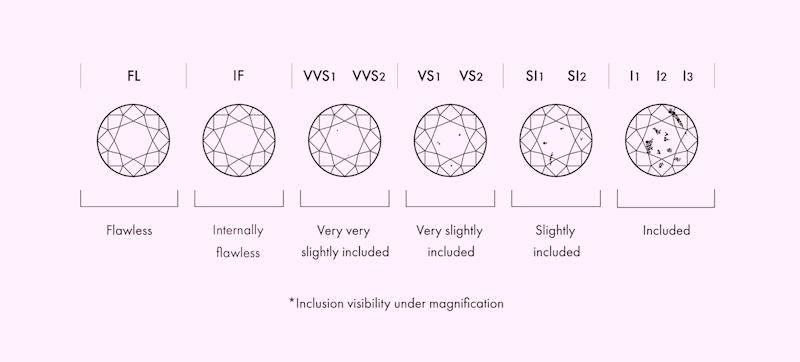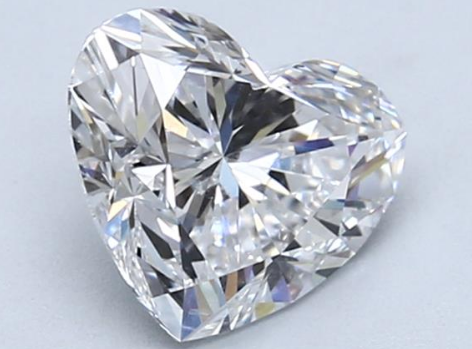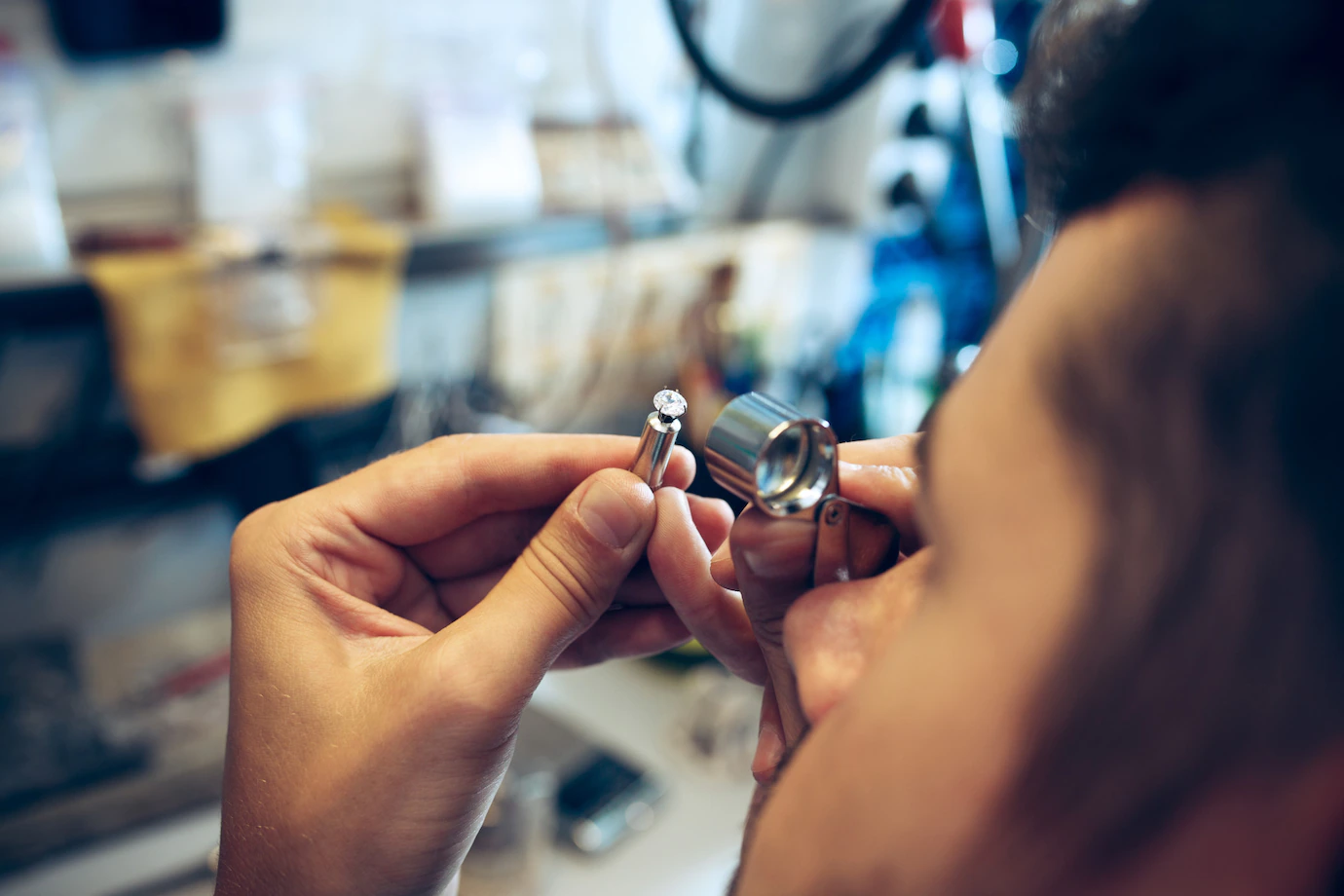
SI1 Diamonds Explained: What Does This Clarity Grade Mean?
SI1 clarity refers to a diamond’s level of inclusions and blemishes. Inclusions are internal flaws within the diamond, while blemishes are external imperfections on the diamond’s surface. In the diamond grading system, SI1 clarity is considered to be a high-quality clarity grade, but not the highest.
SI1 clarity diamonds will typically have inclusions and blemishes that are noticeable to a trained gemologist using a 10x magnification loupe, but are not visible to the naked eye. These inclusions and blemishes are small and not very prominent, and do not affect the diamond’s overall appearance or durability.
A Generally High Amount Blemishes And Inclusions
The presence of inclusions and blemishes in a diamond can affect its overall value. In general, diamonds with fewer inclusions and blemishes are considered to be more valuable. However, the size, location, and type of inclusions and blemishes can also affect a diamond’s value. For example, a diamond with a small, faint inclusion in the center of the diamond may be less valuable than a diamond with a larger, more noticeable inclusion on the edge of the diamond.
SI1 clarity diamonds are a good choice for those who want a high-quality diamond without spending a fortune. They offer a good balance of clarity and affordability, and can be a great option for those looking to create a beautiful piece of jewelry on a budget.
Yet, Still Around The Middle Range
In terms of diamond grading, SI1 clarity is considered to be in the middle range of the clarity scale. It falls between the higher-grade VVS2 clarity and the lower-grade SI2 clarity. VVS2 clarity diamonds have very, very small inclusions that are only visible under a 10x magnification loupe, while SI2 clarity diamonds have inclusions and blemishes that are visible to the naked eye.
Overall, SI1 clarity diamonds are a great option for those who want a high-quality diamond that is not too expensive. They offer a good balance of clarity, value, and affordability, and can be a great choice for creating a beautiful piece of jewelry.
Here is an example of an SI1 diamond:

5 Reasons To Consider Buying SI1 Diamonds:
- High Quality: SI1 diamonds signify a high clarity grade. Inclusions might be spotted under 10x magnification but aren’t easily discernible to the unaided eye. This ensures these stones retain significant sparkle and brilliance.
- Affordability: When compared to clarity grades like VVS1 or VVS2, SI1 diamonds tend to be more cost-effective, providing commendable quality and value at a more appealing price point.
- Resale Value: Recognized for their high caliber, SI1 diamonds often yield a satisfactory resale value. Acquiring an SI1 diamond could mean a promising return on investment if reselling becomes a future option.
- Durability: Diamonds can have inclusions acting as weak spots, making them prone to damage. The fewer inclusions in SI1 diamonds render them more resilient than some of their counterparts.
- Aesthetic Appeal: Despite the presence of minor inclusions, SI1 diamonds boast commendable clarity and a pristine appearance, enhancing the allure of jewelry. Furthermore, inclusions in these diamonds tend to be subtler to the unaided eye compared to those in clarity grades like I1 or I2.

5 Reasons To Choose A Higher Grade Of Clarity
- Higher clarity grades are rarer and more valuable. Diamonds with higher clarity grades, such as VVS1 or VVS2, are considered to be rarer and more valuable than those with lower clarity grades, such as SI1 or SI2. As a result, purchasing a higher clarity diamond can be a good investment, as it may retain or increase its value over time.
- Higher clarity diamonds have fewer inclusions. Inclusions and blemishes in diamonds can act as points of weakness, making the diamond more susceptible to chipping or breaking. Diamonds with higher clarity grades, such as VVS1 or VVS2, have fewer inclusions and are generally more durable than those with lower clarity grades.
- Higher clarity diamonds have a better appearance. Higher clarity diamonds have fewer inclusions and a higher level of sparkle and brilliance, which can enhance their overall appearance. This can make them more aesthetically pleasing and create a stunning visual effect.
- Higher clarity diamonds may be easier to sell. Because they are considered to be rarer and more valuable, higher clarity diamonds may be easier to sell if you decide to do so in the future. This can provide a good return on your investment and allow you to recoup some of the cost of purchasing the diamond.
- Higher clarity diamonds may be more desirable to some people. For some people, owning a high clarity diamond is a status symbol that signifies their access to high quality, rare gemstones. If you are purchasing a diamond for someone who values rarity and quality, a higher clarity diamond may be more desirable and appreciated.
In Conclusion About SI2 Diamonds
When it comes to choosing a diamond, the concept of beauty is highly subjective and personal. What one person considers to be beautiful may not be the same as what another person considers to be beautiful. This is because beauty is based on individual preferences and tastes, and can be influenced by a wide range of factors, such as personal style, cultural background, and individual experiences.
In the context of diamonds, the clarity of a diamond is one of the criteria that can affect its overall beauty. A diamond with a high clarity grade, such as VVS1 or VVS2, may have fewer inclusions and a higher level of sparkle and brilliance, which can enhance its overall appearance. However, the clarity of a diamond is only one factor that can affect its beauty, and it should be considered in relation to the other criteria, such as the cut, color, and carat weight of the diamond.
Ultimately, the clarity of a diamond that is considered to be beautiful is a matter of personal preference. Some people may prefer a diamond with a high clarity grade, while others may prefer a diamond with a lower clarity grade. It is important to consider all of the criteria and choose a diamond that meets your personal preferences and tastes.